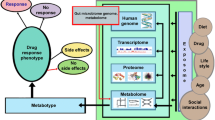Abstract
The scientific community has increasingly recognized metabolic alterations as being critical components or even drivers of human disease. Metabolism of Human Diseases discusses the metabolism and signaling pathways in tissues and organs known to be relevant for common human diseases. It thus bridges the existing gap between biochemistry and physiology textbooks, on the one hand, and pathology textbooks, on the other hand.
Access provided by Autonomous University of Puebla. Download chapter PDF
Similar content being viewed by others
Keywords
- Pathology Textbooks
- Common Human Diseases
- Physiology Textbooks
- Signaling Pathways
- Tissue-specific Metabolism
These keywords were added by machine and not by the authors. This process is experimental and the keywords may be updated as the learning algorithm improves.
The scientific community has increasingly recognized metabolic alterations as being critical components or even drivers of human disease. Metabolism of Human Diseases discusses the metabolism and signaling pathways in tissues and organs known to be relevant for common human diseases. It thus bridges the existing gap between biochemistry and physiology textbooks, on the one hand, and pathology textbooks, on the other hand.
Metabolism of Human Diseases is directed at advanced students, doctors, and scientists from all categories of life sciences and medicine (e.g., biochemists, biologists, physiologists, pharmacologists, pharmacists, toxicologists, and physicians) with an interest in the metabolism and molecular mechanisms of human diseases, irrespective of their specialization.
The book is divided into different parts, each related to a human organ or tissue. Each part begins with an overview chapter presenting the anatomic and physiological properties of the organ or tissue in question relevant for the subsequent disease chapters of the section (Fig. 1). The overview introduces organ- or tissue-specific metabolism and signaling pathways as well as intra- and inter-organ communication (i.e., “inside-in,” “inside-out,” and “outside-in” signaling). The disease chapters discuss pathomechanisms of the diseases with emphasis on metabolic alterations and affected signaling pathways. In addition, they briefly introduce major treatments currently in use and in clinical trials as well as their influence on the patient’s metabolism.
The diseases have been selected to cover a wide spectrum of human diseases in the industrialized world (as described in the tenth edition of the International Classification of Diseases, ICD-10). They include many of the most common (based on diagnosis), most deadly (based on numbers of deaths), and most expensive (based on treatment costs) illnesses.
Each chapter of Metabolism of Human Diseases contains up to three simplified figures and tables that illustrate important elements of anatomy, physiology, metabolism, signaling pathways, or treatment. All figures are presented in a common layout to facilitate understanding of the contents of each chapter (Fig. 2). Since Yousun Koh provided the layout and final presentation, we would like to express our gratitude to her.
Finally, more than a hundred international experts contributed state-of-the-art chapters to the book, and we would like to thank all of them for their work and dedication.
We wish the owner of the book a pleasant read!
Best regards,
Martin Zeeb and Eckhard Lammert
Author information
Authors and Affiliations
Corresponding author
Editor information
Editors and Affiliations
Rights and permissions
Copyright information
© 2014 Springer-Verlag Wien
About this chapter
Cite this chapter
Zeeb, M., Lammert, E. (2014). Introduction. In: Lammert, E., Zeeb, M. (eds) Metabolism of Human Diseases. Springer, Vienna. https://doi.org/10.1007/978-3-7091-0715-7_1
Download citation
DOI: https://doi.org/10.1007/978-3-7091-0715-7_1
Published:
Publisher Name: Springer, Vienna
Print ISBN: 978-3-7091-0714-0
Online ISBN: 978-3-7091-0715-7
eBook Packages: Biomedical and Life SciencesBiomedical and Life Sciences (R0)






